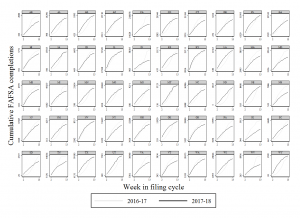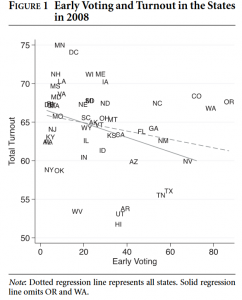Every week, the U.S. Department of Education releases data on the number high school seniors who have submitted and completed the FAFSA form. Two UW doc students and I are downloading, archiving, and analyzing this data each week and below is a chart summarizing completions for each state and week of the current cycle (2017-18) and last year’s cycle (2016-17).
Tracking completions by this “week-in-cycle” approach is a first step in monitoring progress and tracking the rhythms of the filing cycle. Notice how there is an early boost in several states, where completions are above last year’s levels. But then notice in most states how that boost seems to flatten out when compared to last year’s cycle.
Nationally, the number completions is down by about 20% from the same time in last year’s cycle. This could simply be because the two FAFSA cycles do not match up on the calendar: Week 13 of the current cycle spans from October 1st to December 23rd, 2016, while Week 13 of last year’s cycle spans from January 1st to March 25th.
For example, California’s deadline is March 2nd and it didn’t change from last year. Week 13 spanned that deadline last year, but not this year. As state filing deadlines pass, we will take a closer look at each one to see whether there is a bump in filing. We are looking closely at Tennessee since the TN Promise deadline is Jan 17 (Feb 15 last year).
Ultimately, we want to know whether earlier and easier filing increases overall FAFSA filing rates. We won’t be able to answer that definitively with our data, but we think we’re taking a step in the right direction.
This is a similar public policy question asked by fellow UW faculty members, who were curious if early voting brings more voters to the polls. This is a complicated question to answer, but they found the short answer was “no” as shown below.
Surprisingly, early voting may actually depress overall voter turnout. However, when states have election-day registration or couple election-day registration with early voting, they see higher turnout. The authors’ conclusion has stuck with me and is occupying my attention, “election reform has goals other than increasing voter turnout, including minimizing cost and administrative burden…”
We don’t have to squint too hard to see the similarities between these two contexts: making a bureaucratic process easier and earlier does not necessarily increase overall participation. It very well may (and I hope/think it will) with the FAFSA. Drawing lessons from other areas of social science can help us think about higher education in new and creative ways. Doing so might also help us stumble upon new solutions to age-old problems.
If we find that overall filing rates didn’t tick up (or didn’t tick up as much as anticipated) then perhaps we need the equivalent of “election-day registration” for the FAFSA. I don’t even know what that might look like, but it’s something we might need to anticipate if the trends in the chart above don’t pick back up in March when many states’ deadlines are up.

